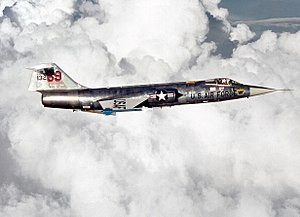F-104A Starfighter
| F-104 Starfighter | |
|---|---|
 |
|
| A U.S. Air Force Lockheed F-104G Starfighter | |
| Role | Interceptor aircraft, fighter-bomber |
| National origin | United States |
| Manufacturer | Lockheed |
| First flight | 17 February 1956 (YF-104A) |
| Introduction | 20 February 1958 |
| Retired | 31 October 2004 (Italy) |
| Status | Retired, except for private operators |
| Primary users |
United States Air Force German Air Force Japan Air Self-Defense Force Turkish Air Force |
| Number built | 2,578 |
| Unit cost |
US$1.42 million (F-104G)
|
| Developed from | Lockheed XF-104 |
| Variants |
Lockheed NF-104A Canadair CF-104 Aeritalia F-104S |
| Developed into | CL-1200 Lancer and X-27, Lockheed CL-288 |
| Lockheed F-104 Starfighter Cutaway | |
|
|
The Lockheed F-104 Starfighter is a single-engine, supersonic interceptor aircraft which later became widely used as an attack aircraft. It was originally developed by Lockheed for the United States Air Force (USAF), but became widely used by US Allies around the world, and produced by several other NATO nations. One of the Century Series of fighter aircraft, it was operated by the air forces of more than a dozen nations from 1958 to 2004. Its design team was led by Kelly Johnson, who went on to lead or contribute to the development of the Lockheed SR-71 Blackbird and other Lockheed aircraft.
The F-104 set numerous world records, including both airspeed and altitude records. Its success was marred by the Lockheed bribery scandals, in which Lockheed had given bribes to a considerable number of political and military figures in various nations in order to influence their judgment and secure several purchase contracts; this caused considerable political controversy in Europe and Japan.
The poor safety record of the Starfighter also brought the aircraft into the public eye, especially in German Air Force service. Fighter ace Erich Hartmann was forced to retire from the Luftwaffe due to his outspoken opposition to selection of the F-104.
The ultimate production version of the fighter model was the F-104S, an all-weather interceptor designed by Aeritalia for the Italian Air Force, and equipped with radar-guided AIM-7 Sparrow missiles. An advanced F-104 with a high-mounted wing, known as the CL-1200 Lancer, was considered but did not proceed past the mock-up stage.
Clarence "Kelly" Johnson, the chief engineer at Lockheed's Skunk Works, visited Korea in December 1951 and spoke with fighter pilots about what sort of aircraft they wanted. At the time, the U.S. pilots were confronting the MiG-15 with North American F-86 Sabres, and many felt that the MiGs were superior to the larger and more complex American design. The pilots requested a small and simple aircraft with excellent performance. Armed with this information, Johnson immediately started the design of such an aircraft on his return to the United States. In March, his team was assembled; they studied several aircraft designs, ranging from small designs at 8,000 lb (3,600 kg), to fairly large ones at 50,000 lb (23,000 kg). In order to achieve the desired performance, Lockheed chose a minimalist approach: a design that would achieve high performance by wrapping the lightest, most aerodynamically efficient airframe possible around a single powerful engine. The engine chosen was the new General Electric J79, an engine of dramatically improved performance in comparison with contemporary designs. The small L-246 design powered by a single J79 remained essentially identical to the L-083 Starfighter as eventually delivered.
...
Wikipedia
